Clinical Nutrition: Pathophysiology, Diet, and Disease Management
VerifiedAdded on 2023/01/23
|11
|3306
|90
Report
AI Summary
This clinical nutrition report provides an overview of the digestive system, including the pathophysiology of gastrointestinal disorders, such as gastritis, IBD, and ulcers, and the role of diet in their management. It further examines eating disorders like anorexia and bulimia, detailing their causes, treatments, and the importance of nutritional planning. The report also explores the relationship between diet and cardiovascular disease, focusing on atherosclerosis and the nutritional considerations for CVD and CHD. Additionally, it delves into the role of diet in cancer genesis and prevention, discussing the impact of various nutrients and inflammatory syndromes. Finally, the report covers blood glucose regulation and dysregulation, including diabetes, and the principles of energy balance, including BMI and obesity management. This report emphasizes the critical role of diet in disease prevention and management.
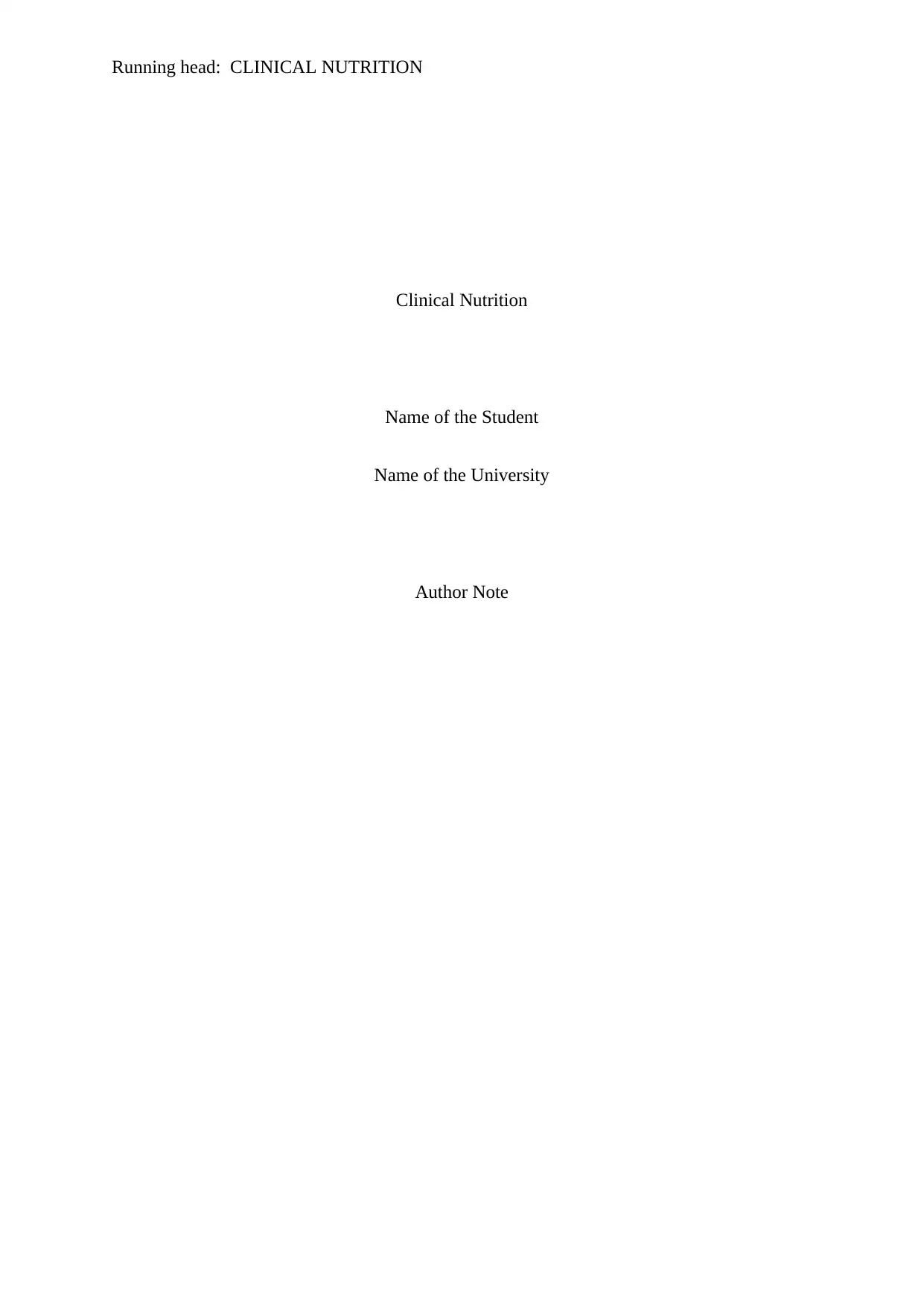
Running head: CLINICAL NUTRITION
Clinical Nutrition
Name of the Student
Name of the University
Author Note
Clinical Nutrition
Name of the Student
Name of the University
Author Note
Paraphrase This Document
Need a fresh take? Get an instant paraphrase of this document with our AI Paraphraser
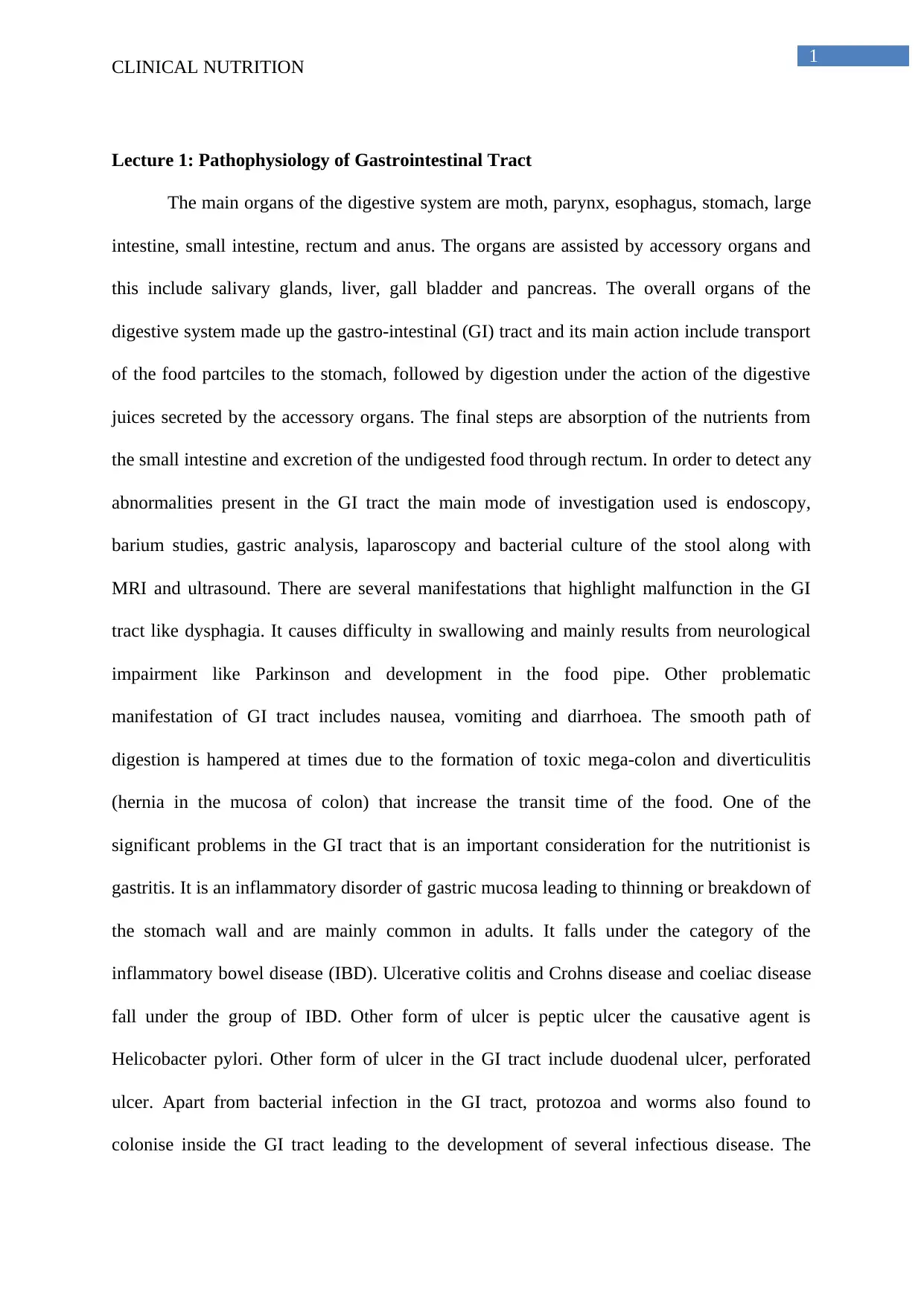
1
CLINICAL NUTRITION
Lecture 1: Pathophysiology of Gastrointestinal Tract
The main organs of the digestive system are moth, parynx, esophagus, stomach, large
intestine, small intestine, rectum and anus. The organs are assisted by accessory organs and
this include salivary glands, liver, gall bladder and pancreas. The overall organs of the
digestive system made up the gastro-intestinal (GI) tract and its main action include transport
of the food partciles to the stomach, followed by digestion under the action of the digestive
juices secreted by the accessory organs. The final steps are absorption of the nutrients from
the small intestine and excretion of the undigested food through rectum. In order to detect any
abnormalities present in the GI tract the main mode of investigation used is endoscopy,
barium studies, gastric analysis, laparoscopy and bacterial culture of the stool along with
MRI and ultrasound. There are several manifestations that highlight malfunction in the GI
tract like dysphagia. It causes difficulty in swallowing and mainly results from neurological
impairment like Parkinson and development in the food pipe. Other problematic
manifestation of GI tract includes nausea, vomiting and diarrhoea. The smooth path of
digestion is hampered at times due to the formation of toxic mega-colon and diverticulitis
(hernia in the mucosa of colon) that increase the transit time of the food. One of the
significant problems in the GI tract that is an important consideration for the nutritionist is
gastritis. It is an inflammatory disorder of gastric mucosa leading to thinning or breakdown of
the stomach wall and are mainly common in adults. It falls under the category of the
inflammatory bowel disease (IBD). Ulcerative colitis and Crohns disease and coeliac disease
fall under the group of IBD. Other form of ulcer is peptic ulcer the causative agent is
Helicobacter pylori. Other form of ulcer in the GI tract include duodenal ulcer, perforated
ulcer. Apart from bacterial infection in the GI tract, protozoa and worms also found to
colonise inside the GI tract leading to the development of several infectious disease. The
CLINICAL NUTRITION
Lecture 1: Pathophysiology of Gastrointestinal Tract
The main organs of the digestive system are moth, parynx, esophagus, stomach, large
intestine, small intestine, rectum and anus. The organs are assisted by accessory organs and
this include salivary glands, liver, gall bladder and pancreas. The overall organs of the
digestive system made up the gastro-intestinal (GI) tract and its main action include transport
of the food partciles to the stomach, followed by digestion under the action of the digestive
juices secreted by the accessory organs. The final steps are absorption of the nutrients from
the small intestine and excretion of the undigested food through rectum. In order to detect any
abnormalities present in the GI tract the main mode of investigation used is endoscopy,
barium studies, gastric analysis, laparoscopy and bacterial culture of the stool along with
MRI and ultrasound. There are several manifestations that highlight malfunction in the GI
tract like dysphagia. It causes difficulty in swallowing and mainly results from neurological
impairment like Parkinson and development in the food pipe. Other problematic
manifestation of GI tract includes nausea, vomiting and diarrhoea. The smooth path of
digestion is hampered at times due to the formation of toxic mega-colon and diverticulitis
(hernia in the mucosa of colon) that increase the transit time of the food. One of the
significant problems in the GI tract that is an important consideration for the nutritionist is
gastritis. It is an inflammatory disorder of gastric mucosa leading to thinning or breakdown of
the stomach wall and are mainly common in adults. It falls under the category of the
inflammatory bowel disease (IBD). Ulcerative colitis and Crohns disease and coeliac disease
fall under the group of IBD. Other form of ulcer is peptic ulcer the causative agent is
Helicobacter pylori. Other form of ulcer in the GI tract include duodenal ulcer, perforated
ulcer. Apart from bacterial infection in the GI tract, protozoa and worms also found to
colonise inside the GI tract leading to the development of several infectious disease. The
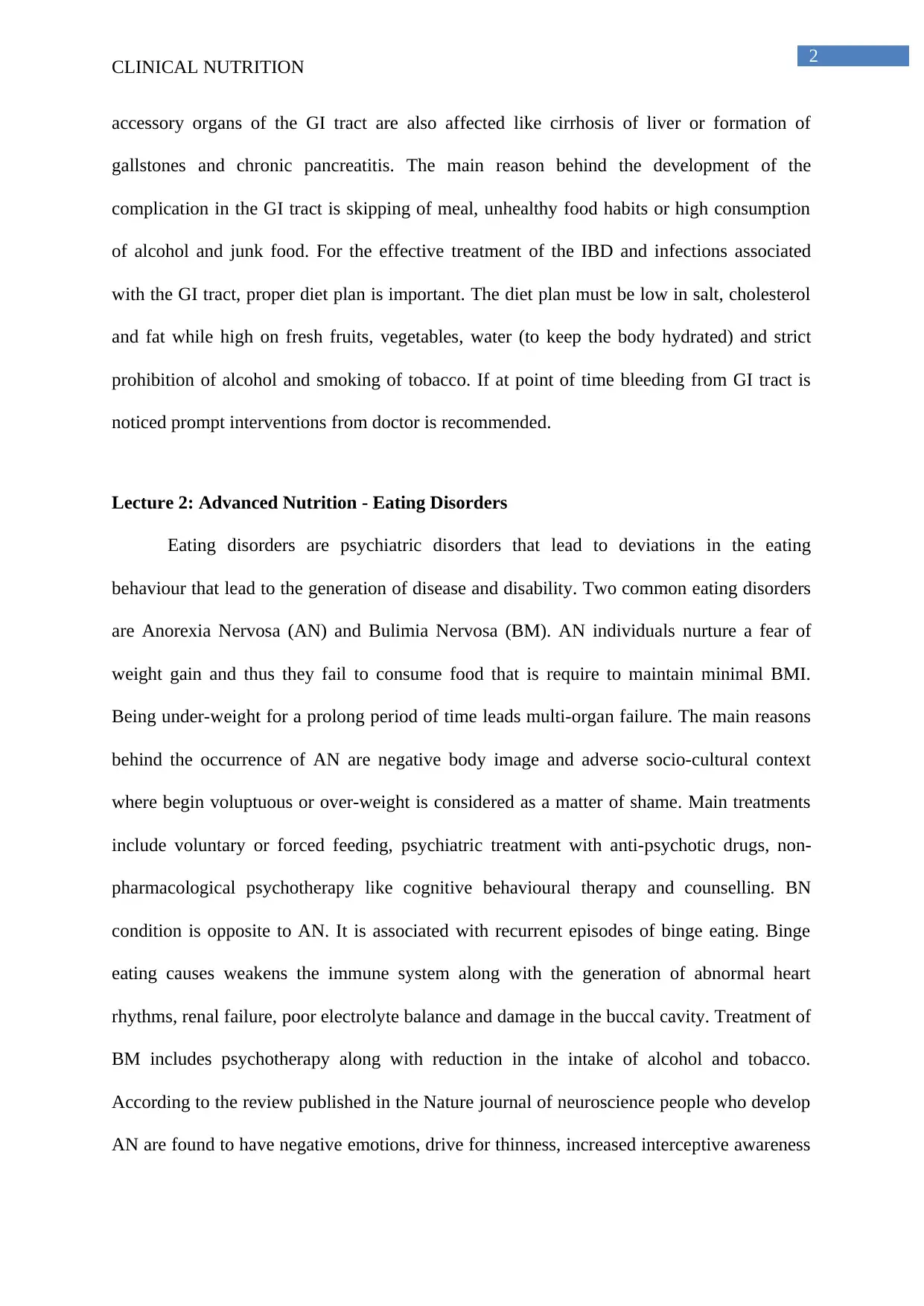
2
CLINICAL NUTRITION
accessory organs of the GI tract are also affected like cirrhosis of liver or formation of
gallstones and chronic pancreatitis. The main reason behind the development of the
complication in the GI tract is skipping of meal, unhealthy food habits or high consumption
of alcohol and junk food. For the effective treatment of the IBD and infections associated
with the GI tract, proper diet plan is important. The diet plan must be low in salt, cholesterol
and fat while high on fresh fruits, vegetables, water (to keep the body hydrated) and strict
prohibition of alcohol and smoking of tobacco. If at point of time bleeding from GI tract is
noticed prompt interventions from doctor is recommended.
Lecture 2: Advanced Nutrition - Eating Disorders
Eating disorders are psychiatric disorders that lead to deviations in the eating
behaviour that lead to the generation of disease and disability. Two common eating disorders
are Anorexia Nervosa (AN) and Bulimia Nervosa (BM). AN individuals nurture a fear of
weight gain and thus they fail to consume food that is require to maintain minimal BMI.
Being under-weight for a prolong period of time leads multi-organ failure. The main reasons
behind the occurrence of AN are negative body image and adverse socio-cultural context
where begin voluptuous or over-weight is considered as a matter of shame. Main treatments
include voluntary or forced feeding, psychiatric treatment with anti-psychotic drugs, non-
pharmacological psychotherapy like cognitive behavioural therapy and counselling. BN
condition is opposite to AN. It is associated with recurrent episodes of binge eating. Binge
eating causes weakens the immune system along with the generation of abnormal heart
rhythms, renal failure, poor electrolyte balance and damage in the buccal cavity. Treatment of
BM includes psychotherapy along with reduction in the intake of alcohol and tobacco.
According to the review published in the Nature journal of neuroscience people who develop
AN are found to have negative emotions, drive for thinness, increased interceptive awareness
CLINICAL NUTRITION
accessory organs of the GI tract are also affected like cirrhosis of liver or formation of
gallstones and chronic pancreatitis. The main reason behind the development of the
complication in the GI tract is skipping of meal, unhealthy food habits or high consumption
of alcohol and junk food. For the effective treatment of the IBD and infections associated
with the GI tract, proper diet plan is important. The diet plan must be low in salt, cholesterol
and fat while high on fresh fruits, vegetables, water (to keep the body hydrated) and strict
prohibition of alcohol and smoking of tobacco. If at point of time bleeding from GI tract is
noticed prompt interventions from doctor is recommended.
Lecture 2: Advanced Nutrition - Eating Disorders
Eating disorders are psychiatric disorders that lead to deviations in the eating
behaviour that lead to the generation of disease and disability. Two common eating disorders
are Anorexia Nervosa (AN) and Bulimia Nervosa (BM). AN individuals nurture a fear of
weight gain and thus they fail to consume food that is require to maintain minimal BMI.
Being under-weight for a prolong period of time leads multi-organ failure. The main reasons
behind the occurrence of AN are negative body image and adverse socio-cultural context
where begin voluptuous or over-weight is considered as a matter of shame. Main treatments
include voluntary or forced feeding, psychiatric treatment with anti-psychotic drugs, non-
pharmacological psychotherapy like cognitive behavioural therapy and counselling. BN
condition is opposite to AN. It is associated with recurrent episodes of binge eating. Binge
eating causes weakens the immune system along with the generation of abnormal heart
rhythms, renal failure, poor electrolyte balance and damage in the buccal cavity. Treatment of
BM includes psychotherapy along with reduction in the intake of alcohol and tobacco.
According to the review published in the Nature journal of neuroscience people who develop
AN are found to have negative emotions, drive for thinness, increased interceptive awareness
⊘ This is a preview!⊘
Do you want full access?
Subscribe today to unlock all pages.

Trusted by 1+ million students worldwide
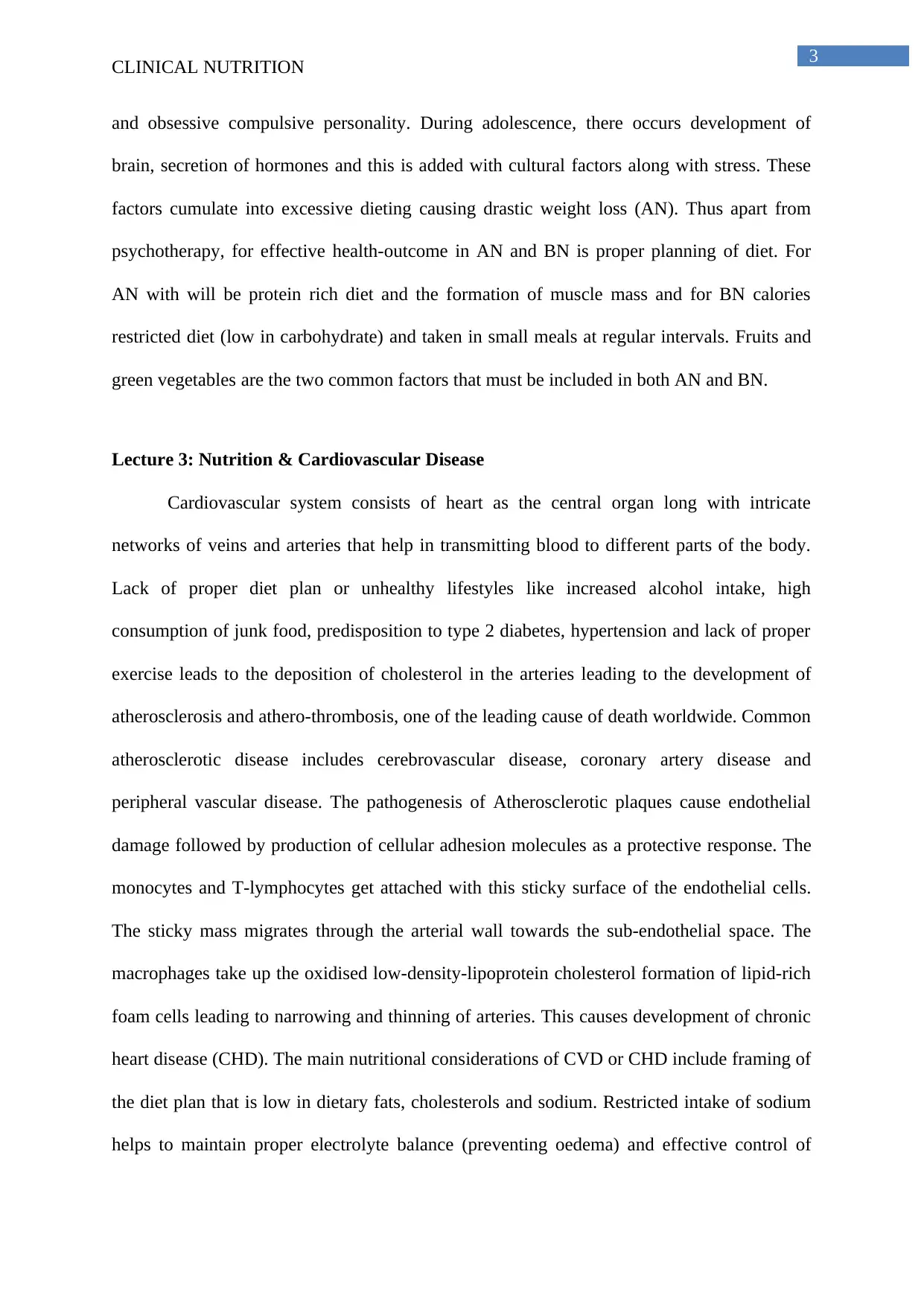
3
CLINICAL NUTRITION
and obsessive compulsive personality. During adolescence, there occurs development of
brain, secretion of hormones and this is added with cultural factors along with stress. These
factors cumulate into excessive dieting causing drastic weight loss (AN). Thus apart from
psychotherapy, for effective health-outcome in AN and BN is proper planning of diet. For
AN with will be protein rich diet and the formation of muscle mass and for BN calories
restricted diet (low in carbohydrate) and taken in small meals at regular intervals. Fruits and
green vegetables are the two common factors that must be included in both AN and BN.
Lecture 3: Nutrition & Cardiovascular Disease
Cardiovascular system consists of heart as the central organ long with intricate
networks of veins and arteries that help in transmitting blood to different parts of the body.
Lack of proper diet plan or unhealthy lifestyles like increased alcohol intake, high
consumption of junk food, predisposition to type 2 diabetes, hypertension and lack of proper
exercise leads to the deposition of cholesterol in the arteries leading to the development of
atherosclerosis and athero-thrombosis, one of the leading cause of death worldwide. Common
atherosclerotic disease includes cerebrovascular disease, coronary artery disease and
peripheral vascular disease. The pathogenesis of Atherosclerotic plaques cause endothelial
damage followed by production of cellular adhesion molecules as a protective response. The
monocytes and T-lymphocytes get attached with this sticky surface of the endothelial cells.
The sticky mass migrates through the arterial wall towards the sub-endothelial space. The
macrophages take up the oxidised low-density-lipoprotein cholesterol formation of lipid-rich
foam cells leading to narrowing and thinning of arteries. This causes development of chronic
heart disease (CHD). The main nutritional considerations of CVD or CHD include framing of
the diet plan that is low in dietary fats, cholesterols and sodium. Restricted intake of sodium
helps to maintain proper electrolyte balance (preventing oedema) and effective control of
CLINICAL NUTRITION
and obsessive compulsive personality. During adolescence, there occurs development of
brain, secretion of hormones and this is added with cultural factors along with stress. These
factors cumulate into excessive dieting causing drastic weight loss (AN). Thus apart from
psychotherapy, for effective health-outcome in AN and BN is proper planning of diet. For
AN with will be protein rich diet and the formation of muscle mass and for BN calories
restricted diet (low in carbohydrate) and taken in small meals at regular intervals. Fruits and
green vegetables are the two common factors that must be included in both AN and BN.
Lecture 3: Nutrition & Cardiovascular Disease
Cardiovascular system consists of heart as the central organ long with intricate
networks of veins and arteries that help in transmitting blood to different parts of the body.
Lack of proper diet plan or unhealthy lifestyles like increased alcohol intake, high
consumption of junk food, predisposition to type 2 diabetes, hypertension and lack of proper
exercise leads to the deposition of cholesterol in the arteries leading to the development of
atherosclerosis and athero-thrombosis, one of the leading cause of death worldwide. Common
atherosclerotic disease includes cerebrovascular disease, coronary artery disease and
peripheral vascular disease. The pathogenesis of Atherosclerotic plaques cause endothelial
damage followed by production of cellular adhesion molecules as a protective response. The
monocytes and T-lymphocytes get attached with this sticky surface of the endothelial cells.
The sticky mass migrates through the arterial wall towards the sub-endothelial space. The
macrophages take up the oxidised low-density-lipoprotein cholesterol formation of lipid-rich
foam cells leading to narrowing and thinning of arteries. This causes development of chronic
heart disease (CHD). The main nutritional considerations of CVD or CHD include framing of
the diet plan that is low in dietary fats, cholesterols and sodium. Restricted intake of sodium
helps to maintain proper electrolyte balance (preventing oedema) and effective control of
Paraphrase This Document
Need a fresh take? Get an instant paraphrase of this document with our AI Paraphraser
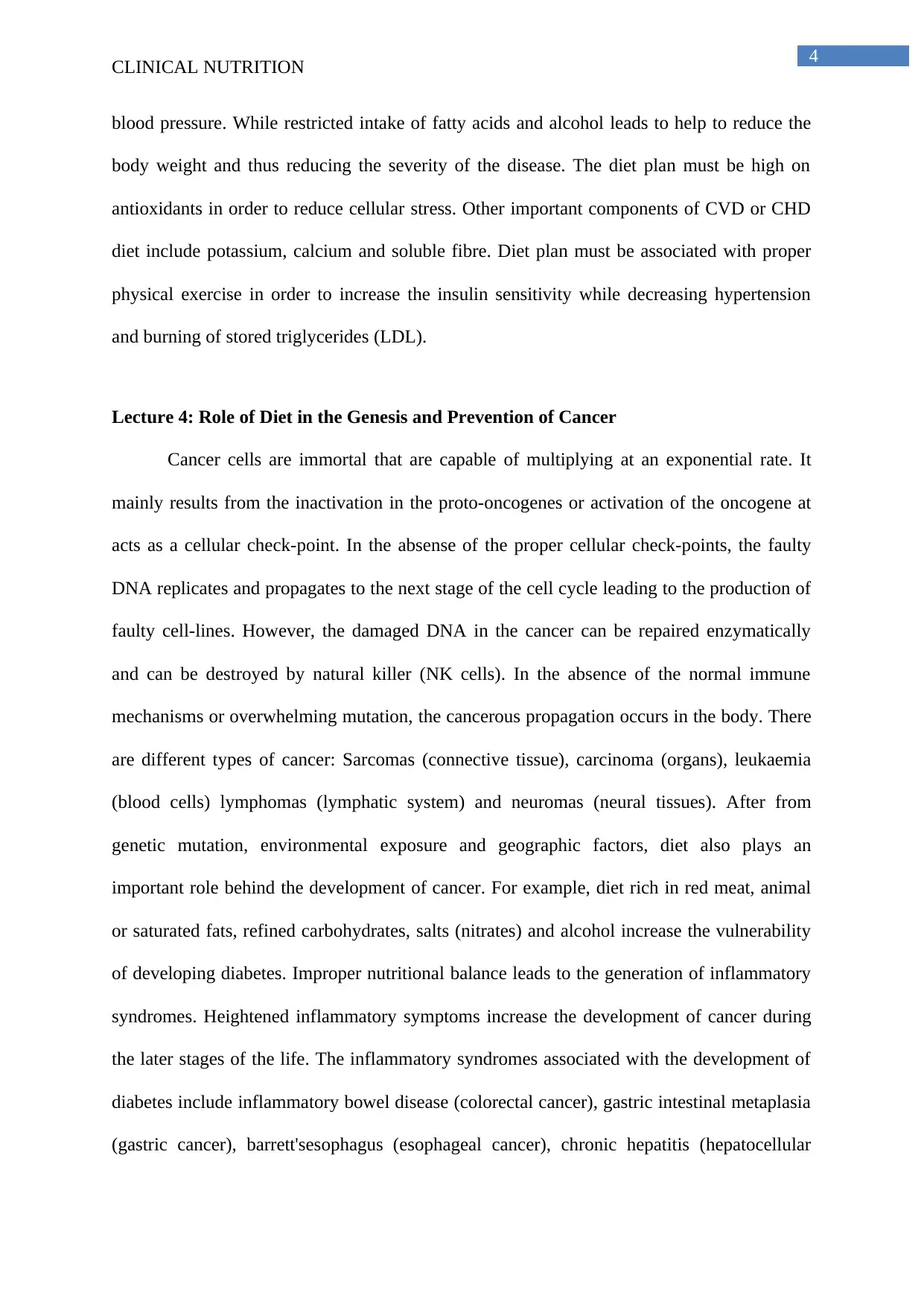
4
CLINICAL NUTRITION
blood pressure. While restricted intake of fatty acids and alcohol leads to help to reduce the
body weight and thus reducing the severity of the disease. The diet plan must be high on
antioxidants in order to reduce cellular stress. Other important components of CVD or CHD
diet include potassium, calcium and soluble fibre. Diet plan must be associated with proper
physical exercise in order to increase the insulin sensitivity while decreasing hypertension
and burning of stored triglycerides (LDL).
Lecture 4: Role of Diet in the Genesis and Prevention of Cancer
Cancer cells are immortal that are capable of multiplying at an exponential rate. It
mainly results from the inactivation in the proto-oncogenes or activation of the oncogene at
acts as a cellular check-point. In the absense of the proper cellular check-points, the faulty
DNA replicates and propagates to the next stage of the cell cycle leading to the production of
faulty cell-lines. However, the damaged DNA in the cancer can be repaired enzymatically
and can be destroyed by natural killer (NK cells). In the absence of the normal immune
mechanisms or overwhelming mutation, the cancerous propagation occurs in the body. There
are different types of cancer: Sarcomas (connective tissue), carcinoma (organs), leukaemia
(blood cells) lymphomas (lymphatic system) and neuromas (neural tissues). After from
genetic mutation, environmental exposure and geographic factors, diet also plays an
important role behind the development of cancer. For example, diet rich in red meat, animal
or saturated fats, refined carbohydrates, salts (nitrates) and alcohol increase the vulnerability
of developing diabetes. Improper nutritional balance leads to the generation of inflammatory
syndromes. Heightened inflammatory symptoms increase the development of cancer during
the later stages of the life. The inflammatory syndromes associated with the development of
diabetes include inflammatory bowel disease (colorectal cancer), gastric intestinal metaplasia
(gastric cancer), barrett'sesophagus (esophageal cancer), chronic hepatitis (hepatocellular
CLINICAL NUTRITION
blood pressure. While restricted intake of fatty acids and alcohol leads to help to reduce the
body weight and thus reducing the severity of the disease. The diet plan must be high on
antioxidants in order to reduce cellular stress. Other important components of CVD or CHD
diet include potassium, calcium and soluble fibre. Diet plan must be associated with proper
physical exercise in order to increase the insulin sensitivity while decreasing hypertension
and burning of stored triglycerides (LDL).
Lecture 4: Role of Diet in the Genesis and Prevention of Cancer
Cancer cells are immortal that are capable of multiplying at an exponential rate. It
mainly results from the inactivation in the proto-oncogenes or activation of the oncogene at
acts as a cellular check-point. In the absense of the proper cellular check-points, the faulty
DNA replicates and propagates to the next stage of the cell cycle leading to the production of
faulty cell-lines. However, the damaged DNA in the cancer can be repaired enzymatically
and can be destroyed by natural killer (NK cells). In the absence of the normal immune
mechanisms or overwhelming mutation, the cancerous propagation occurs in the body. There
are different types of cancer: Sarcomas (connective tissue), carcinoma (organs), leukaemia
(blood cells) lymphomas (lymphatic system) and neuromas (neural tissues). After from
genetic mutation, environmental exposure and geographic factors, diet also plays an
important role behind the development of cancer. For example, diet rich in red meat, animal
or saturated fats, refined carbohydrates, salts (nitrates) and alcohol increase the vulnerability
of developing diabetes. Improper nutritional balance leads to the generation of inflammatory
syndromes. Heightened inflammatory symptoms increase the development of cancer during
the later stages of the life. The inflammatory syndromes associated with the development of
diabetes include inflammatory bowel disease (colorectal cancer), gastric intestinal metaplasia
(gastric cancer), barrett'sesophagus (esophageal cancer), chronic hepatitis (hepatocellular
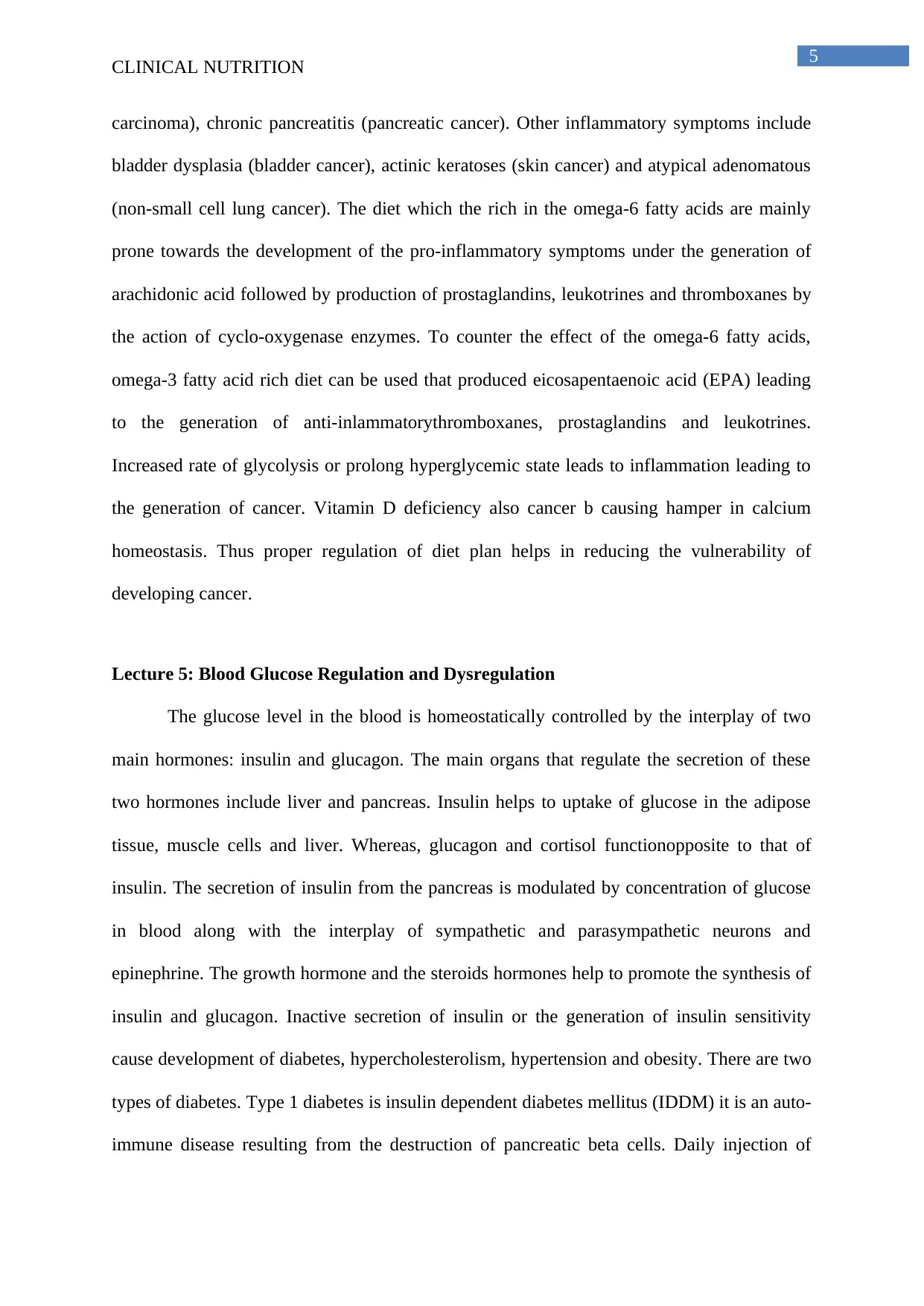
5
CLINICAL NUTRITION
carcinoma), chronic pancreatitis (pancreatic cancer). Other inflammatory symptoms include
bladder dysplasia (bladder cancer), actinic keratoses (skin cancer) and atypical adenomatous
(non-small cell lung cancer). The diet which the rich in the omega-6 fatty acids are mainly
prone towards the development of the pro-inflammatory symptoms under the generation of
arachidonic acid followed by production of prostaglandins, leukotrines and thromboxanes by
the action of cyclo-oxygenase enzymes. To counter the effect of the omega-6 fatty acids,
omega-3 fatty acid rich diet can be used that produced eicosapentaenoic acid (EPA) leading
to the generation of anti-inlammatorythromboxanes, prostaglandins and leukotrines.
Increased rate of glycolysis or prolong hyperglycemic state leads to inflammation leading to
the generation of cancer. Vitamin D deficiency also cancer b causing hamper in calcium
homeostasis. Thus proper regulation of diet plan helps in reducing the vulnerability of
developing cancer.
Lecture 5: Blood Glucose Regulation and Dysregulation
The glucose level in the blood is homeostatically controlled by the interplay of two
main hormones: insulin and glucagon. The main organs that regulate the secretion of these
two hormones include liver and pancreas. Insulin helps to uptake of glucose in the adipose
tissue, muscle cells and liver. Whereas, glucagon and cortisol functionopposite to that of
insulin. The secretion of insulin from the pancreas is modulated by concentration of glucose
in blood along with the interplay of sympathetic and parasympathetic neurons and
epinephrine. The growth hormone and the steroids hormones help to promote the synthesis of
insulin and glucagon. Inactive secretion of insulin or the generation of insulin sensitivity
cause development of diabetes, hypercholesterolism, hypertension and obesity. There are two
types of diabetes. Type 1 diabetes is insulin dependent diabetes mellitus (IDDM) it is an auto-
immune disease resulting from the destruction of pancreatic beta cells. Daily injection of
CLINICAL NUTRITION
carcinoma), chronic pancreatitis (pancreatic cancer). Other inflammatory symptoms include
bladder dysplasia (bladder cancer), actinic keratoses (skin cancer) and atypical adenomatous
(non-small cell lung cancer). The diet which the rich in the omega-6 fatty acids are mainly
prone towards the development of the pro-inflammatory symptoms under the generation of
arachidonic acid followed by production of prostaglandins, leukotrines and thromboxanes by
the action of cyclo-oxygenase enzymes. To counter the effect of the omega-6 fatty acids,
omega-3 fatty acid rich diet can be used that produced eicosapentaenoic acid (EPA) leading
to the generation of anti-inlammatorythromboxanes, prostaglandins and leukotrines.
Increased rate of glycolysis or prolong hyperglycemic state leads to inflammation leading to
the generation of cancer. Vitamin D deficiency also cancer b causing hamper in calcium
homeostasis. Thus proper regulation of diet plan helps in reducing the vulnerability of
developing cancer.
Lecture 5: Blood Glucose Regulation and Dysregulation
The glucose level in the blood is homeostatically controlled by the interplay of two
main hormones: insulin and glucagon. The main organs that regulate the secretion of these
two hormones include liver and pancreas. Insulin helps to uptake of glucose in the adipose
tissue, muscle cells and liver. Whereas, glucagon and cortisol functionopposite to that of
insulin. The secretion of insulin from the pancreas is modulated by concentration of glucose
in blood along with the interplay of sympathetic and parasympathetic neurons and
epinephrine. The growth hormone and the steroids hormones help to promote the synthesis of
insulin and glucagon. Inactive secretion of insulin or the generation of insulin sensitivity
cause development of diabetes, hypercholesterolism, hypertension and obesity. There are two
types of diabetes. Type 1 diabetes is insulin dependent diabetes mellitus (IDDM) it is an auto-
immune disease resulting from the destruction of pancreatic beta cells. Daily injection of
⊘ This is a preview!⊘
Do you want full access?
Subscribe today to unlock all pages.

Trusted by 1+ million students worldwide
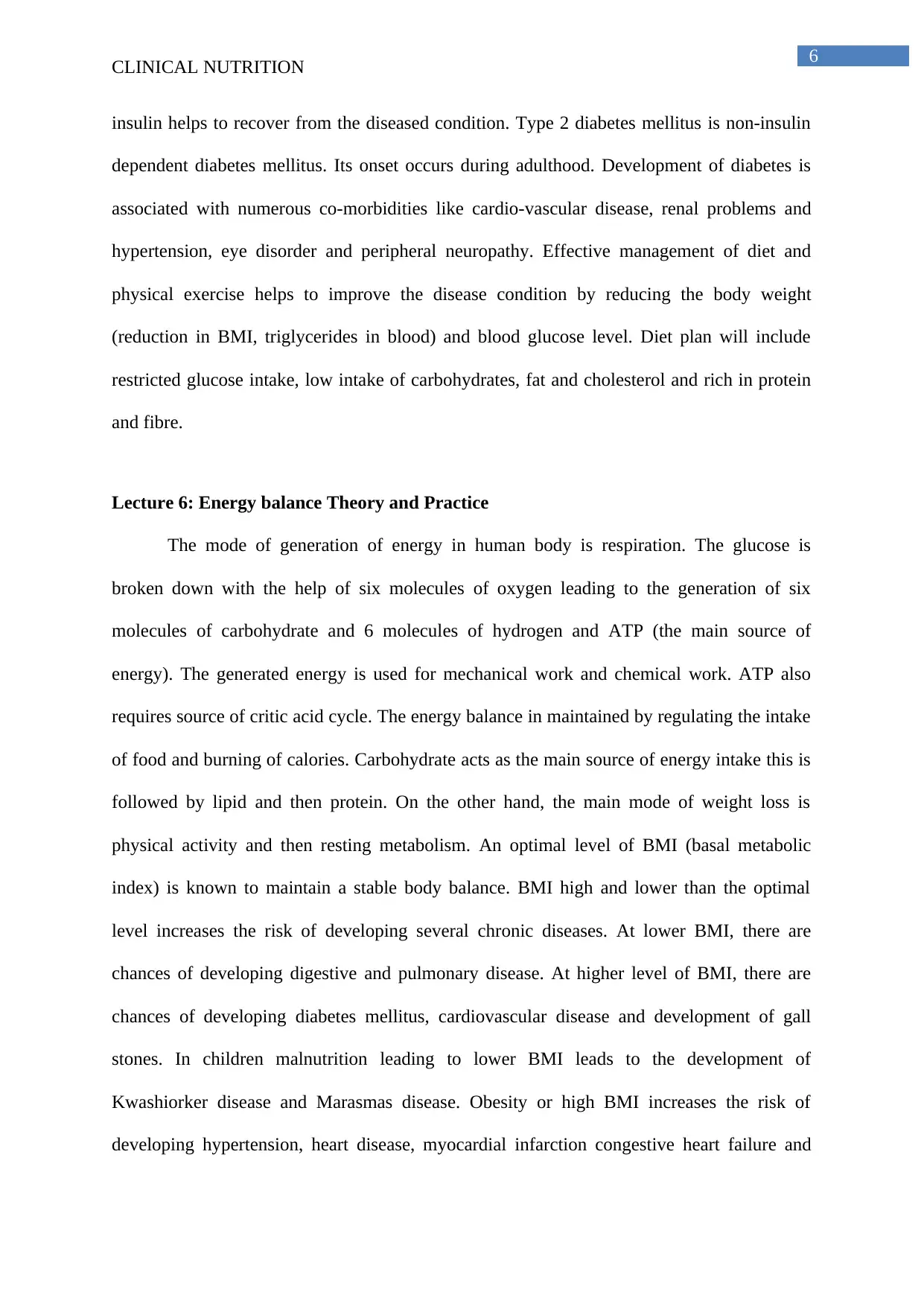
6
CLINICAL NUTRITION
insulin helps to recover from the diseased condition. Type 2 diabetes mellitus is non-insulin
dependent diabetes mellitus. Its onset occurs during adulthood. Development of diabetes is
associated with numerous co-morbidities like cardio-vascular disease, renal problems and
hypertension, eye disorder and peripheral neuropathy. Effective management of diet and
physical exercise helps to improve the disease condition by reducing the body weight
(reduction in BMI, triglycerides in blood) and blood glucose level. Diet plan will include
restricted glucose intake, low intake of carbohydrates, fat and cholesterol and rich in protein
and fibre.
Lecture 6: Energy balance Theory and Practice
The mode of generation of energy in human body is respiration. The glucose is
broken down with the help of six molecules of oxygen leading to the generation of six
molecules of carbohydrate and 6 molecules of hydrogen and ATP (the main source of
energy). The generated energy is used for mechanical work and chemical work. ATP also
requires source of critic acid cycle. The energy balance in maintained by regulating the intake
of food and burning of calories. Carbohydrate acts as the main source of energy intake this is
followed by lipid and then protein. On the other hand, the main mode of weight loss is
physical activity and then resting metabolism. An optimal level of BMI (basal metabolic
index) is known to maintain a stable body balance. BMI high and lower than the optimal
level increases the risk of developing several chronic diseases. At lower BMI, there are
chances of developing digestive and pulmonary disease. At higher level of BMI, there are
chances of developing diabetes mellitus, cardiovascular disease and development of gall
stones. In children malnutrition leading to lower BMI leads to the development of
Kwashiorker disease and Marasmas disease. Obesity or high BMI increases the risk of
developing hypertension, heart disease, myocardial infarction congestive heart failure and
CLINICAL NUTRITION
insulin helps to recover from the diseased condition. Type 2 diabetes mellitus is non-insulin
dependent diabetes mellitus. Its onset occurs during adulthood. Development of diabetes is
associated with numerous co-morbidities like cardio-vascular disease, renal problems and
hypertension, eye disorder and peripheral neuropathy. Effective management of diet and
physical exercise helps to improve the disease condition by reducing the body weight
(reduction in BMI, triglycerides in blood) and blood glucose level. Diet plan will include
restricted glucose intake, low intake of carbohydrates, fat and cholesterol and rich in protein
and fibre.
Lecture 6: Energy balance Theory and Practice
The mode of generation of energy in human body is respiration. The glucose is
broken down with the help of six molecules of oxygen leading to the generation of six
molecules of carbohydrate and 6 molecules of hydrogen and ATP (the main source of
energy). The generated energy is used for mechanical work and chemical work. ATP also
requires source of critic acid cycle. The energy balance in maintained by regulating the intake
of food and burning of calories. Carbohydrate acts as the main source of energy intake this is
followed by lipid and then protein. On the other hand, the main mode of weight loss is
physical activity and then resting metabolism. An optimal level of BMI (basal metabolic
index) is known to maintain a stable body balance. BMI high and lower than the optimal
level increases the risk of developing several chronic diseases. At lower BMI, there are
chances of developing digestive and pulmonary disease. At higher level of BMI, there are
chances of developing diabetes mellitus, cardiovascular disease and development of gall
stones. In children malnutrition leading to lower BMI leads to the development of
Kwashiorker disease and Marasmas disease. Obesity or high BMI increases the risk of
developing hypertension, heart disease, myocardial infarction congestive heart failure and
Paraphrase This Document
Need a fresh take? Get an instant paraphrase of this document with our AI Paraphraser
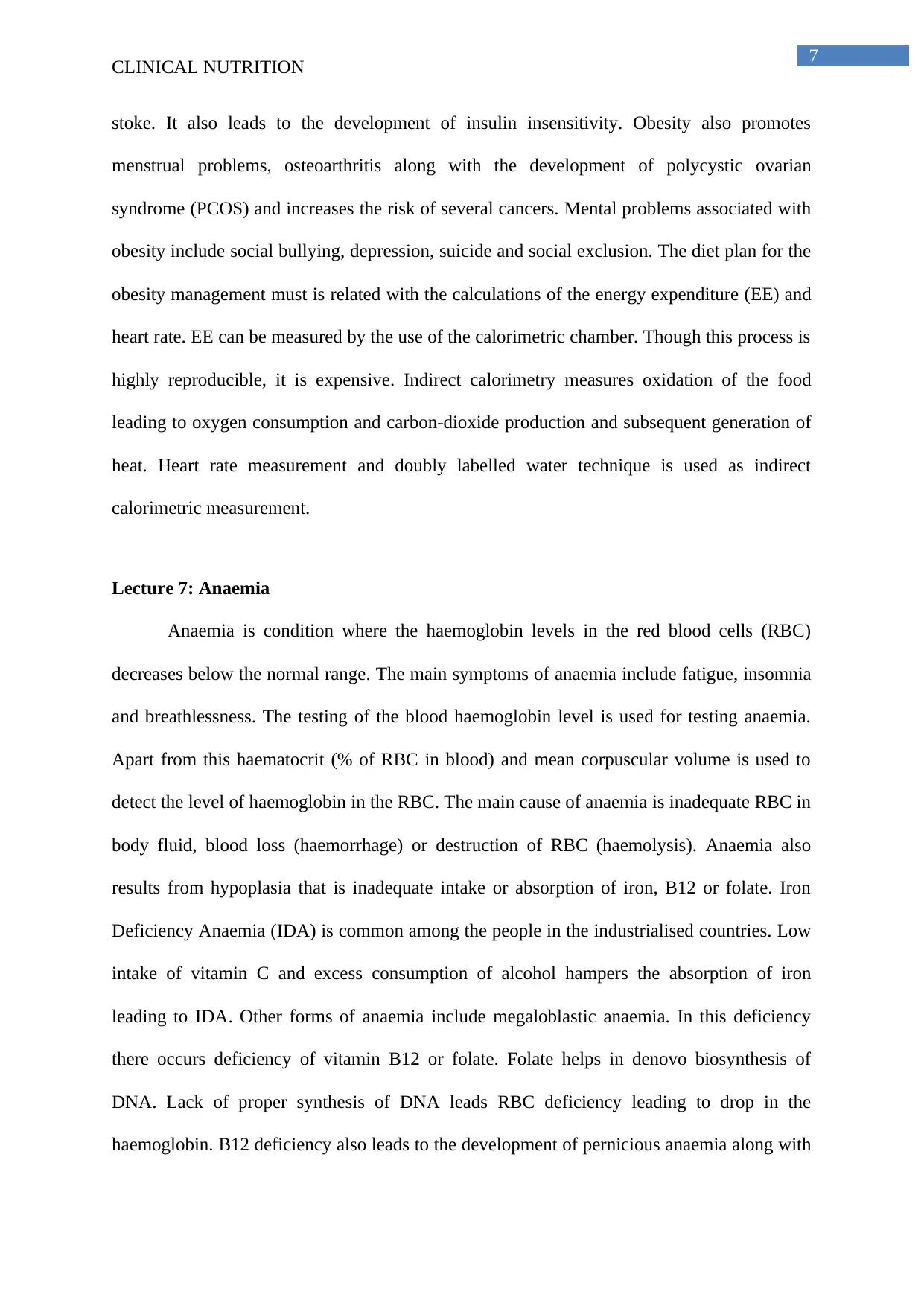
7
CLINICAL NUTRITION
stoke. It also leads to the development of insulin insensitivity. Obesity also promotes
menstrual problems, osteoarthritis along with the development of polycystic ovarian
syndrome (PCOS) and increases the risk of several cancers. Mental problems associated with
obesity include social bullying, depression, suicide and social exclusion. The diet plan for the
obesity management must is related with the calculations of the energy expenditure (EE) and
heart rate. EE can be measured by the use of the calorimetric chamber. Though this process is
highly reproducible, it is expensive. Indirect calorimetry measures oxidation of the food
leading to oxygen consumption and carbon-dioxide production and subsequent generation of
heat. Heart rate measurement and doubly labelled water technique is used as indirect
calorimetric measurement.
Lecture 7: Anaemia
Anaemia is condition where the haemoglobin levels in the red blood cells (RBC)
decreases below the normal range. The main symptoms of anaemia include fatigue, insomnia
and breathlessness. The testing of the blood haemoglobin level is used for testing anaemia.
Apart from this haematocrit (% of RBC in blood) and mean corpuscular volume is used to
detect the level of haemoglobin in the RBC. The main cause of anaemia is inadequate RBC in
body fluid, blood loss (haemorrhage) or destruction of RBC (haemolysis). Anaemia also
results from hypoplasia that is inadequate intake or absorption of iron, B12 or folate. Iron
Deficiency Anaemia (IDA) is common among the people in the industrialised countries. Low
intake of vitamin C and excess consumption of alcohol hampers the absorption of iron
leading to IDA. Other forms of anaemia include megaloblastic anaemia. In this deficiency
there occurs deficiency of vitamin B12 or folate. Folate helps in denovo biosynthesis of
DNA. Lack of proper synthesis of DNA leads RBC deficiency leading to drop in the
haemoglobin. B12 deficiency also leads to the development of pernicious anaemia along with
CLINICAL NUTRITION
stoke. It also leads to the development of insulin insensitivity. Obesity also promotes
menstrual problems, osteoarthritis along with the development of polycystic ovarian
syndrome (PCOS) and increases the risk of several cancers. Mental problems associated with
obesity include social bullying, depression, suicide and social exclusion. The diet plan for the
obesity management must is related with the calculations of the energy expenditure (EE) and
heart rate. EE can be measured by the use of the calorimetric chamber. Though this process is
highly reproducible, it is expensive. Indirect calorimetry measures oxidation of the food
leading to oxygen consumption and carbon-dioxide production and subsequent generation of
heat. Heart rate measurement and doubly labelled water technique is used as indirect
calorimetric measurement.
Lecture 7: Anaemia
Anaemia is condition where the haemoglobin levels in the red blood cells (RBC)
decreases below the normal range. The main symptoms of anaemia include fatigue, insomnia
and breathlessness. The testing of the blood haemoglobin level is used for testing anaemia.
Apart from this haematocrit (% of RBC in blood) and mean corpuscular volume is used to
detect the level of haemoglobin in the RBC. The main cause of anaemia is inadequate RBC in
body fluid, blood loss (haemorrhage) or destruction of RBC (haemolysis). Anaemia also
results from hypoplasia that is inadequate intake or absorption of iron, B12 or folate. Iron
Deficiency Anaemia (IDA) is common among the people in the industrialised countries. Low
intake of vitamin C and excess consumption of alcohol hampers the absorption of iron
leading to IDA. Other forms of anaemia include megaloblastic anaemia. In this deficiency
there occurs deficiency of vitamin B12 or folate. Folate helps in denovo biosynthesis of
DNA. Lack of proper synthesis of DNA leads RBC deficiency leading to drop in the
haemoglobin. B12 deficiency also leads to the development of pernicious anaemia along with
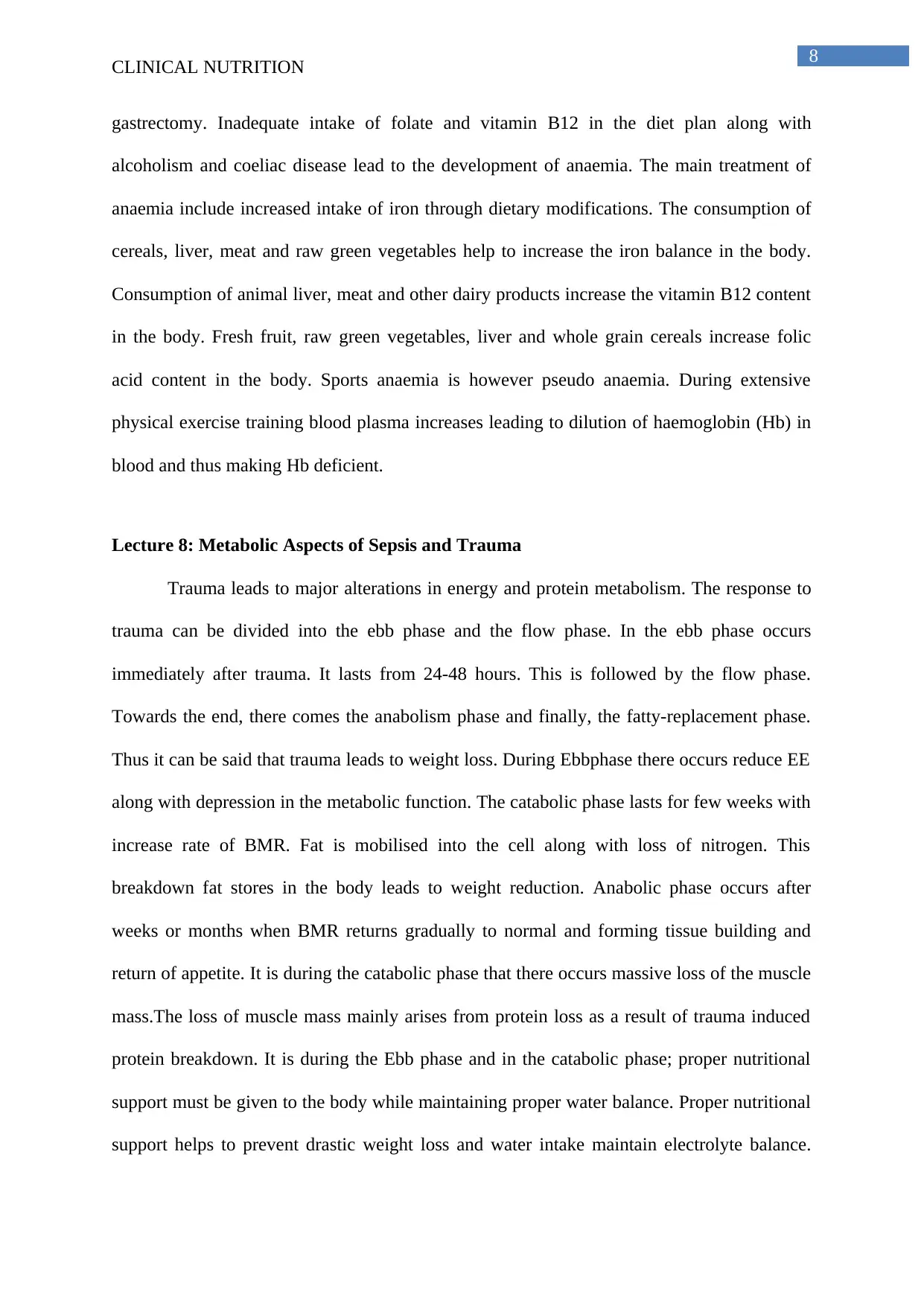
8
CLINICAL NUTRITION
gastrectomy. Inadequate intake of folate and vitamin B12 in the diet plan along with
alcoholism and coeliac disease lead to the development of anaemia. The main treatment of
anaemia include increased intake of iron through dietary modifications. The consumption of
cereals, liver, meat and raw green vegetables help to increase the iron balance in the body.
Consumption of animal liver, meat and other dairy products increase the vitamin B12 content
in the body. Fresh fruit, raw green vegetables, liver and whole grain cereals increase folic
acid content in the body. Sports anaemia is however pseudo anaemia. During extensive
physical exercise training blood plasma increases leading to dilution of haemoglobin (Hb) in
blood and thus making Hb deficient.
Lecture 8: Metabolic Aspects of Sepsis and Trauma
Trauma leads to major alterations in energy and protein metabolism. The response to
trauma can be divided into the ebb phase and the flow phase. In the ebb phase occurs
immediately after trauma. It lasts from 24-48 hours. This is followed by the flow phase.
Towards the end, there comes the anabolism phase and finally, the fatty-replacement phase.
Thus it can be said that trauma leads to weight loss. During Ebbphase there occurs reduce EE
along with depression in the metabolic function. The catabolic phase lasts for few weeks with
increase rate of BMR. Fat is mobilised into the cell along with loss of nitrogen. This
breakdown fat stores in the body leads to weight reduction. Anabolic phase occurs after
weeks or months when BMR returns gradually to normal and forming tissue building and
return of appetite. It is during the catabolic phase that there occurs massive loss of the muscle
mass.The loss of muscle mass mainly arises from protein loss as a result of trauma induced
protein breakdown. It is during the Ebb phase and in the catabolic phase; proper nutritional
support must be given to the body while maintaining proper water balance. Proper nutritional
support helps to prevent drastic weight loss and water intake maintain electrolyte balance.
CLINICAL NUTRITION
gastrectomy. Inadequate intake of folate and vitamin B12 in the diet plan along with
alcoholism and coeliac disease lead to the development of anaemia. The main treatment of
anaemia include increased intake of iron through dietary modifications. The consumption of
cereals, liver, meat and raw green vegetables help to increase the iron balance in the body.
Consumption of animal liver, meat and other dairy products increase the vitamin B12 content
in the body. Fresh fruit, raw green vegetables, liver and whole grain cereals increase folic
acid content in the body. Sports anaemia is however pseudo anaemia. During extensive
physical exercise training blood plasma increases leading to dilution of haemoglobin (Hb) in
blood and thus making Hb deficient.
Lecture 8: Metabolic Aspects of Sepsis and Trauma
Trauma leads to major alterations in energy and protein metabolism. The response to
trauma can be divided into the ebb phase and the flow phase. In the ebb phase occurs
immediately after trauma. It lasts from 24-48 hours. This is followed by the flow phase.
Towards the end, there comes the anabolism phase and finally, the fatty-replacement phase.
Thus it can be said that trauma leads to weight loss. During Ebbphase there occurs reduce EE
along with depression in the metabolic function. The catabolic phase lasts for few weeks with
increase rate of BMR. Fat is mobilised into the cell along with loss of nitrogen. This
breakdown fat stores in the body leads to weight reduction. Anabolic phase occurs after
weeks or months when BMR returns gradually to normal and forming tissue building and
return of appetite. It is during the catabolic phase that there occurs massive loss of the muscle
mass.The loss of muscle mass mainly arises from protein loss as a result of trauma induced
protein breakdown. It is during the Ebb phase and in the catabolic phase; proper nutritional
support must be given to the body while maintaining proper water balance. Proper nutritional
support helps to prevent drastic weight loss and water intake maintain electrolyte balance.
⊘ This is a preview!⊘
Do you want full access?
Subscribe today to unlock all pages.

Trusted by 1+ million students worldwide
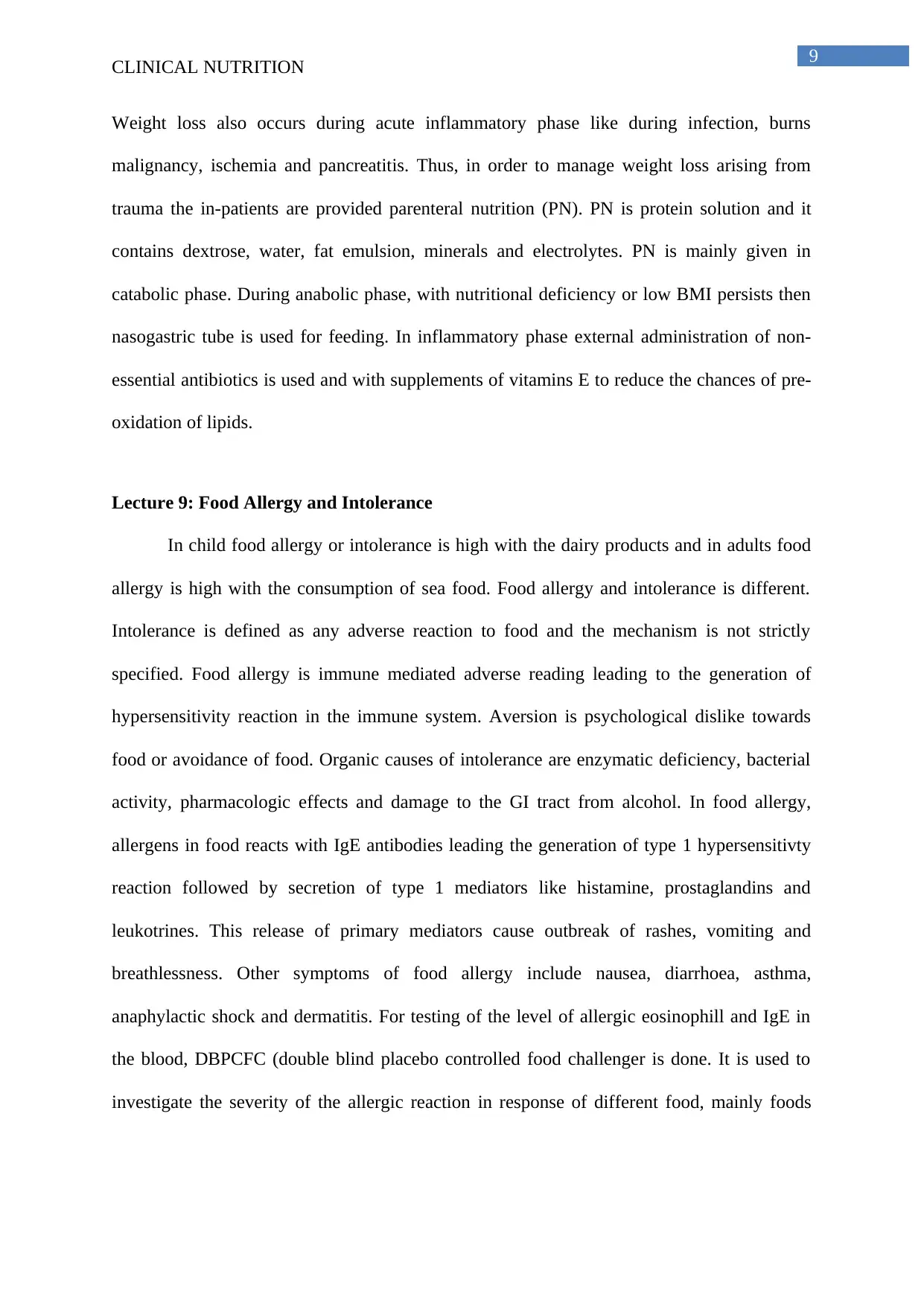
9
CLINICAL NUTRITION
Weight loss also occurs during acute inflammatory phase like during infection, burns
malignancy, ischemia and pancreatitis. Thus, in order to manage weight loss arising from
trauma the in-patients are provided parenteral nutrition (PN). PN is protein solution and it
contains dextrose, water, fat emulsion, minerals and electrolytes. PN is mainly given in
catabolic phase. During anabolic phase, with nutritional deficiency or low BMI persists then
nasogastric tube is used for feeding. In inflammatory phase external administration of non-
essential antibiotics is used and with supplements of vitamins E to reduce the chances of pre-
oxidation of lipids.
Lecture 9: Food Allergy and Intolerance
In child food allergy or intolerance is high with the dairy products and in adults food
allergy is high with the consumption of sea food. Food allergy and intolerance is different.
Intolerance is defined as any adverse reaction to food and the mechanism is not strictly
specified. Food allergy is immune mediated adverse reading leading to the generation of
hypersensitivity reaction in the immune system. Aversion is psychological dislike towards
food or avoidance of food. Organic causes of intolerance are enzymatic deficiency, bacterial
activity, pharmacologic effects and damage to the GI tract from alcohol. In food allergy,
allergens in food reacts with IgE antibodies leading the generation of type 1 hypersensitivty
reaction followed by secretion of type 1 mediators like histamine, prostaglandins and
leukotrines. This release of primary mediators cause outbreak of rashes, vomiting and
breathlessness. Other symptoms of food allergy include nausea, diarrhoea, asthma,
anaphylactic shock and dermatitis. For testing of the level of allergic eosinophill and IgE in
the blood, DBPCFC (double blind placebo controlled food challenger is done. It is used to
investigate the severity of the allergic reaction in response of different food, mainly foods
CLINICAL NUTRITION
Weight loss also occurs during acute inflammatory phase like during infection, burns
malignancy, ischemia and pancreatitis. Thus, in order to manage weight loss arising from
trauma the in-patients are provided parenteral nutrition (PN). PN is protein solution and it
contains dextrose, water, fat emulsion, minerals and electrolytes. PN is mainly given in
catabolic phase. During anabolic phase, with nutritional deficiency or low BMI persists then
nasogastric tube is used for feeding. In inflammatory phase external administration of non-
essential antibiotics is used and with supplements of vitamins E to reduce the chances of pre-
oxidation of lipids.
Lecture 9: Food Allergy and Intolerance
In child food allergy or intolerance is high with the dairy products and in adults food
allergy is high with the consumption of sea food. Food allergy and intolerance is different.
Intolerance is defined as any adverse reaction to food and the mechanism is not strictly
specified. Food allergy is immune mediated adverse reading leading to the generation of
hypersensitivity reaction in the immune system. Aversion is psychological dislike towards
food or avoidance of food. Organic causes of intolerance are enzymatic deficiency, bacterial
activity, pharmacologic effects and damage to the GI tract from alcohol. In food allergy,
allergens in food reacts with IgE antibodies leading the generation of type 1 hypersensitivty
reaction followed by secretion of type 1 mediators like histamine, prostaglandins and
leukotrines. This release of primary mediators cause outbreak of rashes, vomiting and
breathlessness. Other symptoms of food allergy include nausea, diarrhoea, asthma,
anaphylactic shock and dermatitis. For testing of the level of allergic eosinophill and IgE in
the blood, DBPCFC (double blind placebo controlled food challenger is done. It is used to
investigate the severity of the allergic reaction in response of different food, mainly foods
Paraphrase This Document
Need a fresh take? Get an instant paraphrase of this document with our AI Paraphraser
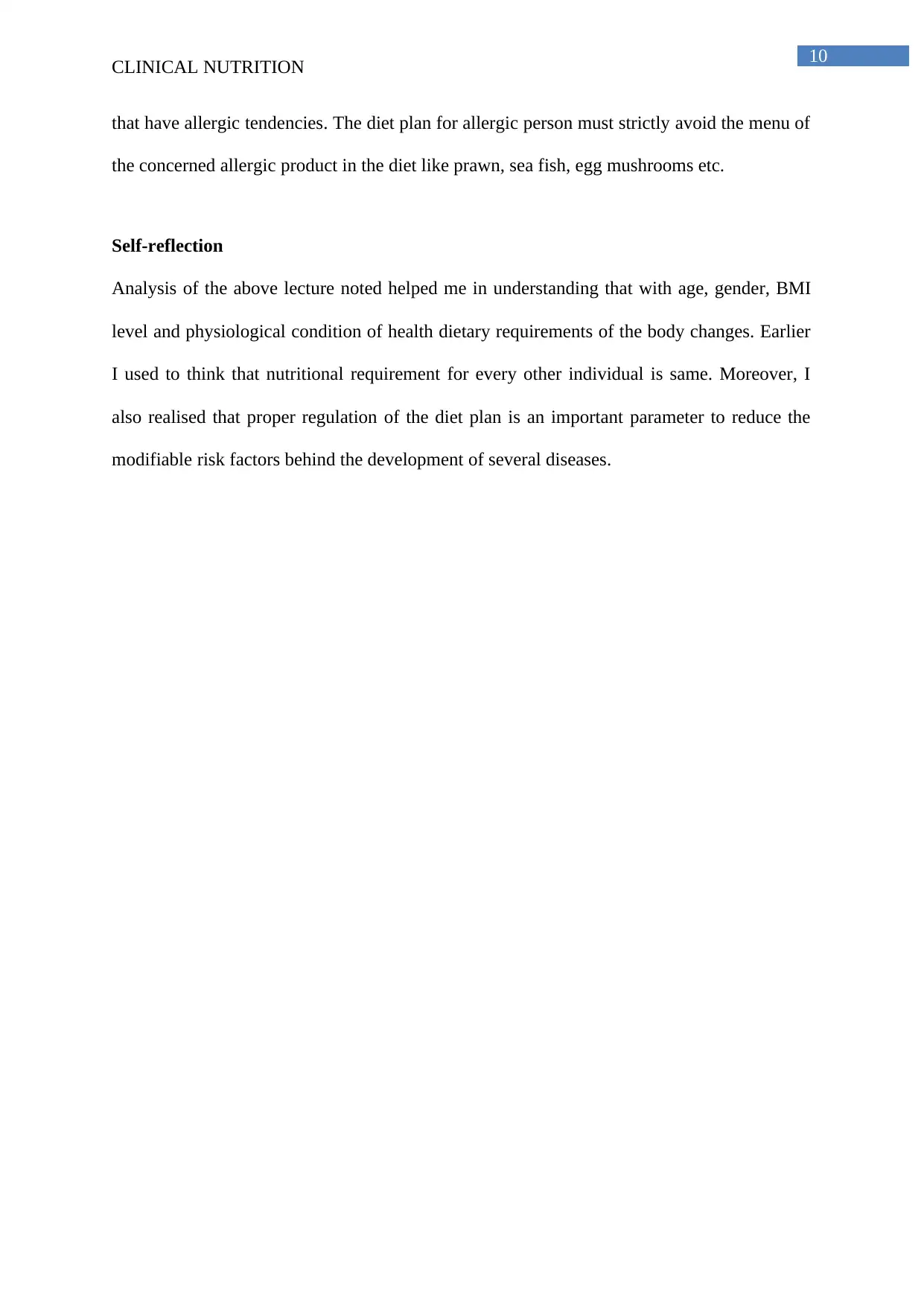
10
CLINICAL NUTRITION
that have allergic tendencies. The diet plan for allergic person must strictly avoid the menu of
the concerned allergic product in the diet like prawn, sea fish, egg mushrooms etc.
Self-reflection
Analysis of the above lecture noted helped me in understanding that with age, gender, BMI
level and physiological condition of health dietary requirements of the body changes. Earlier
I used to think that nutritional requirement for every other individual is same. Moreover, I
also realised that proper regulation of the diet plan is an important parameter to reduce the
modifiable risk factors behind the development of several diseases.
CLINICAL NUTRITION
that have allergic tendencies. The diet plan for allergic person must strictly avoid the menu of
the concerned allergic product in the diet like prawn, sea fish, egg mushrooms etc.
Self-reflection
Analysis of the above lecture noted helped me in understanding that with age, gender, BMI
level and physiological condition of health dietary requirements of the body changes. Earlier
I used to think that nutritional requirement for every other individual is same. Moreover, I
also realised that proper regulation of the diet plan is an important parameter to reduce the
modifiable risk factors behind the development of several diseases.
1 out of 11
Related Documents
Your All-in-One AI-Powered Toolkit for Academic Success.
+13062052269
info@desklib.com
Available 24*7 on WhatsApp / Email
![[object Object]](/_next/static/media/star-bottom.7253800d.svg)
Unlock your academic potential
Copyright © 2020–2025 A2Z Services. All Rights Reserved. Developed and managed by ZUCOL.





